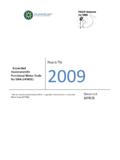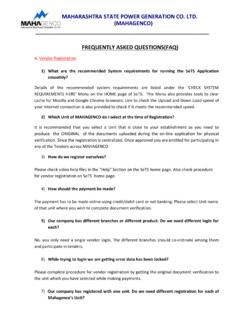Transcription of An expanded version of the Hammersmith Functional Motor ...
1 Neuromuscular Disorders 17 (2007) 693 697. An expanded version of the Hammersmith Functional Motor scale for SMA II and III patients Jessica M. O'Hagen a,*,1, Allan M. Glanzman b,1, Michael P. McDermott d, Patricia A. Ryan a, Jean Flickinger b, Janet Quigley d, Susan Riley d, Erica Sanborn d, Carrie Irvine f, William B. Martens f, Christine Annis f, Rabi Tawil f, Maryam Oskoui a, Basil T. Darras d,e, Richard S. Finkel b,c, Darryl C. De Vivo a a Columbia University, New York, NY, USA. b Children's Hospital of Philadelphia (Pediatrics [RSF] and Physical Therapy [AMG, JF]). c The University of Pennsylvania School of Medicine, Philadelphia, PA, USA. d Children's Hospital Boston, Boston, MA, USA. e Harvard Medical School, Boston, MA, USA. f University of Rochester Medical Center, Rochester, NY, USA. Received 4 January 2007; received in revised form 20 April 2007; accepted 25 May 2007.
2 Abstract Purpose: To develop and evaluate an expanded version of the Hammersmith Functional Motor scale allowing for evaluation of ambulatory SMA patients. Procedures: Thirty-eight patients with SMA type II or III were evaluated using the Gross Motor Function Measure and the Ham- mersmith Functional Motor scale . Based on statistical and clinical criteria, we selected 13 Gross Motor Function Measure items to develop an expanded HFMS. The expanded Hammersmith Functional Motor scale was validated by comparison with the Gross Motor Function Measure minus the 13 items (GMFM-75) and an assessment of clinical function. The reliability of the expanded Hammersmith Functional Motor scale in 36 patients was established. Findings: The expanded Hammersmith Functional Motor scale was highly correlated with the GMFM-75 and the clinical function assessment (p = , and p = ). The expanded Hammersmith Functional Motor scale showed excellent test retest reliability (Inter- national Coordinating Committee = ).
3 Conclusions: The expanded Hammersmith Functional Motor scale allows assessment of high functioning SMA type II and III. patients. Ease of administration and correlation with established Motor function measures justify use in future SMA clinical trials. 2007 Elsevier All rights reserved. Keywords: Spinal Muscular Atrophy; Gross Motor Function Measure; Hammersmith Functional Motor scale ; Outcome measure; Physical therapy 1. Introduction infants and children su er from progressive muscle weak- ness caused by degeneration of lower Motor neurons in Spinal Muscular Atrophy (SMA) is one of the most dev- the spinal cord and brainstem. SMA is caused by homozy- astating neurological diseases of childhood. A ected gous deletion of the Survival of Motor Neurons-1 (SMN1). gene [1,2]. A related gene, SMN2, produces low levels of *. full-length SMN protein due to ine cient splicing. There Corresponding author.
4 Address: 180 Fort Washington Ave., Floor 5 is an inverse correlation between SMN2 copy number Room 517, New York, NY 10032, USA. Tel.: +1 212 342 5767; fax: +1. 212 342 2893. and disease severity, presumably mediated by SMN2. E-mail address: ( O'Hagen). derived full-length SMN protein [3]. Therefore, increasing 1. Shared equally in the design and execution of this manuscript. the amount of full-length SMN protein is a promising 0960-8966/$ - see front matter 2007 Elsevier All rights reserved. 694 O'Hagen et al. / Neuromuscular Disorders 17 (2007) 693 697. treatment strategy [4]. Several drugs targeting gene expres- scored on a 4 point (0 3) Likert scale , and divided into 5. sion have resulted in increased SMN protein in preclinical dimensions: (1) lying and rolling, (2) sitting, (3) crawling assays and are now being investigated as pharmacological and kneeling, (4) standing, (5) walking, running, and jump- candidates for clinical trials in humans [5 8].
5 To test these ing. In addition to the raw score, the results are expressed drugs, well-designed clinical trials using valid, reliable and as a percent of the maximum possible score for each dimen- responsive outcome measures are needed. sion (ranging from 0 to 100 across the 5 dimensions). Clinically, SMA patients are classi ed according to the The GMFM provides a sensitive measure of gross highest Motor function ever achieved: Those with SMA Motor function in children with type II and III SMA. How- type I never achieve independent sitting; those with type ever, since it was developed for children with cerebral palsy II can sit and may stand but do not walk independently; not all the items are appropriate for children with SMA. and those with SMA type III can walk without assistance. For example, items requiring prone positioning cannot be The retention of these Motor milestones is not considered administered e ectively in those with hip exion contrac- in their classi cation.
6 Many individuals with type III later tures. The GMFM can take 45 min to complete which is lose the ability to functionally ambulate [1]. The wide range a disadvantage for its use in SMA clinical trials. of Functional skills in SMA patients, both between and An alternative disease speci c measure of Motor func- within types, and their limited endurance pose obstacles tion designed for SMA type II patients is the HFMS [10]. in designing Motor function assessments. Clinical trials in Motor skills are scored on 20 items using a 3 point (0 2). a relatively rare disease would preferably allow the enroll- Likert scale . It is feasible (taking approximately 15 min ment of a wide phenotypic range of the disease population to administer), requires minimal equipment, is clinically in order to facilitate recruitment and a broad application of meaningful, and has good inter rater reliability [10,14].
7 Results. Therefore, a Motor function measure would ideally However, the limited range of skills that can be assessed allow for the assessment of both SMA type II and type III (independent sitting to taking 4 steps) can result in a ceiling patients. The Gross Motor Function Measure (GMFM) e ect in higher functioning SMA patients. and Motor Function Measure (MFM) both cover the wide The aim of this study is to create a GMFM-derived range of Functional abilities seen in SMA type II and type module that could be added to the HFMS to allow testing III patients, but these tests typically take more time than of patients with type II and type III SMA. Creating one the Hammersmith Functional Motor scale (HFMS), an scale with items that span the observed skill levels would instrument developed for the evaluation of SMA type II allow both groups of patients to participate in the same patients [9 11].
8 Trial using the same Motor function scale . We initially pre- The MFM was developed and validated for use in neu- sented the reliability of the rst version of HFMSE at the romuscular disorders. It shows excellent correlations with a Families of SMA meeting in 2005. Here, we further re ne visual analogue scale given by professionals, as well as, the that measure providing a valid and reliable test that per- Vignos and Brooke scales and the Functional Indepen- mits the evaluation of SMA type II and III patients while dence Measure. The MFM is able to discriminate amongst at the same time being more rapidly administered and thus, the various diagnostic groups that were included in the val- better tolerated than the full GMFM assessment. idation study and it showed adequate internal consistency. However, SMA accounted for only 10% of the tested pop- 2. Patients and methods ulation.
9 In addition, the time to administer the test is con- siderable. The test time exceeds 30 min in the majority of Subjects cases, and some patients take more than an hour to com- plete the MFM [12]. The length of time to administer the Fifty-four subjects with genetically con rmed SMA. test is signi cant because children with SMA fatigue easily. were evaluated at three study sites, as part of the Pediatric In any clinical trial the selected Motor measure will be one Neuromuscular Clinical Research (PNCR) SMA network. of a number of outcomes and testing time and tolerability 38 of these 54 had type II (n = 21, median age = years, will be important considerations. range years) or III (n = 17 median age = years, The GMFM was designed at McMaster University for range years). The remaining 16 subjects had type the assessment of gross Motor skills in patients with cere- I. They were not evaluated using either the HFMS or the bral palsy.
10 It consists of a group of tasks that span the GMFM, and therefore are not included in any analysis. range of skills typically seen in SMA type II and III Informed consent was obtained from all parents and where patients. In previous studies, the reliability of the GMFM appropriate, assent was obtained. was established in patients with SMA ages 2 18 [9,11,13]. The convergent validity of the GMFM was established Clinical evaluators by correlation with muscle strength in patients from 5 to 18 years of age. The discriminant validity was established Trained pediatric physical and occupational therapists by demonstrating the tests ability to di erentiate between within the PNCR Network had previously undergone SMA patients with varying degrees of clinical severity [9], training in the HFMS and the GMFM. Inter rater reliabil- The testing inventory includes 88 items, which are each ity was established.









